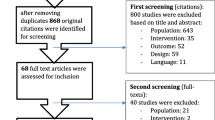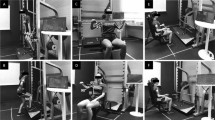Abstract
Purpose
To gain more knowledge about the mechanism (i.e., mediators) of resistance exercise (RE)-induced improvements in physical performance (PP), we seek to investigate whether improvements in muscle strength (MS), muscle power (MP), and lean body mass (LBM) and (or) self-reported fatigue (SRF) are mediators of the effect of RE on PP in breast cancer survivor women (BCSW).
Methods
The volunteers were randomly divided into two groups: control group (CT; n = 9) and resistance exercise (RE; n = 11). The RE protocol consisted of three sets in each exercise (leg extension, leg curl, 45° leg press, and calf raise), between 8 and 12 repetitions per set, with an estimated load of 80% of one-repetition maximum (1RM), and three times a week on non-consecutive days for 12 weeks. The CT group performed only stretching exercises twice a week. SRF, maximal muscle power (Pmax), MP, LBM, and PP were assessed using the Brief Fatigue Inventory Questionnaire; 1RM test; isoinertial dynamometer; DXA; and walking speed, sit-to-stand (STS), and timed up and go (TUG) test, respectively.
Results
Following 12 weeks, the RE group reduced SRF and increased MP, Pmax, LBM, and performance in all tests (walking speed, STS, and TUG) when compared with the CT group. There were significant associations of the changes in LBM, MS, Pmax, and SRF with changes in physical performance tests only in the RE group.
Conclusion
Our findings suggest that improvements in LBM, MS, MP, and self-reported fatigue mediate the effect of resistance exercise on physical performance in BCSW.

Similar content being viewed by others
References
(INCA) BNCI (2018) Câncer de mama (Breast cancer). Brazilian National Cancer Institute INCA, Rio de Janeiro - Brazil
Nounou MI, ElAmrawy F, Ahmed N, Abdelraouf K, Goda S, Syed-Sha-Qhattal H (2015) Breast cancer: conventional diagnosis and treatment modalities and recent patents and technologies. Breast Cancer 9:BCBCR. S29420
Basu P, Lucas E, Carvalho AL, Sauvaget C, Muwonge R, Herrero R, R Sankaranarayanan (2019) Cancer screening in five continents. International Agency for Research on Cancer. https://canscreen5.iarc.fr
Shapiro CL (2018) Cancer survivorship. N Engl J Med 379(25):2438–2450. https://doi.org/10.1056/NEJMra1712502
Hewitt M, Rowland JH, Yancik R (2003) Cancer survivors in the United States: age, health, and disability. J Gerontol Ser A Biol Med Sci 58(1):M82–M91
Brown J, Harhay M, Harhay M (2015) Physical function as a prognostic biomarker among cancer survivors. Br J Cancer 112(1):194–198
Battaglini CL, Mills RC, Phillips BL, Lee JT, Story CE, Nascimento MG, Hackney AC (2014) Twenty-five years of research on the effects of exercise training in breast cancer survivors: a systematic review of the literature. World J Clin Oncol 5(2):177–190
Kirkham AA, Bland KA, Sayyari S, Campbell KL, Davis MK (2016) Clinically relevant physical benefits of exercise interventions in breast cancer survivors. Curr Oncol Rep 18(2):12. https://doi.org/10.1007/s11912-015-0496-3
Campbell KL, Winters-Stone KM, Wiskemann J, May AM, Schwartz AL, Courneya KS, Zucker DS, Matthews CE, Ligibel JA, Gerber LH, Morris GS, Patel AV, Hue TF, Perna FM, Schmitz KH (2019) Exercise guidelines for cancer survivors: consensus statement from international multidisciplinary roundtable. Med Sci Sports Exerc 51(11):2375–2390. https://doi.org/10.1249/MSS.0000000000002116
Swartz MC, Lewis ZH, Lyons EJ, Jennings K, Middleton A, Deer RR, Arnold D, Dresser K, Ottenbacher KJ, Goodwin JS (2017) Effect of home- and community-based physical activity interventions on physical function among cancer survivors: a systematic review and meta-analysis. Arch Phys Med Rehabil 98(8):1652–1665. https://doi.org/10.1016/j.apmr.2017.03.017
Abrahams H, Gielissen M, Schmits I, Verhagen C, Rovers M, Knoop H (2016) Risk factors, prevalence, and course of severe fatigue after breast cancer treatment: a meta-analysis involving 12 327 breast cancer survivors. Ann Oncol 27(6):965–974
Bower JE, Ganz PA, Desmond KA, Rowland JH, Meyerowitz BE, Belin TR (2000) Fatigue in breast cancer survivors: occurrence, correlates, and impact on quality of life. J Clin Oncol 18(4):743–743
Alcazar J, Rodriguez-Lopez C, Ara I, Alfaro-Acha A, Rodríguez-Gómez I, Navarro-Cruz R, Losa-Reyna J, García-García FJ, Alegre LM (2018) Force-velocity profiling in older adults: an adequate tool for the management of functional trajectories with aging. Exp Gerontol 108:1–6
Ward-Ritacco CL, Adrian AL, Johnson MA, Rogers LQ, Evans EM (2014) Adiposity, physical activity, and muscle quality are independently related to physical function performance in middle-aged postmenopausal women. Menopause 21(10):1114–1121
Penttinen H, Saarto T, Kellokumpu-Lehtinen P, Blomqvist C, Huovinen R, Kautiainen H, Järvenpää S, Nikander R, Idman I, Luoto R (2011) Quality of life and physical performance and activity of breast cancer patients after adjuvant treatments. Psycho-Oncology 20(11):1211–1220
Kutynec CL, McCARGAR L, Barr SI, Hislop TG (1999) Energy balance in women with breast during adjuvant treatment. J Am Diet Assoc 99(10):1222–1227
Servaes P, Verhagen S, Bleijenberg G (2002) Determinants of chronic fatigue in disease-free breast cancer patients: a cross-sectional study. Ann Oncol 13(4):589–598
Hayes SC, Rye S, DiSipio T, Yates P, Bashford J, Pyke C, Saunders C, Battistutta D, Eakin E (2013) Exercise for health: a randomized, controlled trial evaluating the impact of a pragmatic, translational exercise intervention on the quality of life, function and treatment-related side effects following breast cancer. Breast Cancer Res Treat 137(1):175–186
Beaudart C, Rolland Y, Cruz-Jentoft AJ, Bauer JM, Sieber C, Cooper C, Al-Daghri N, Araujo de Carvalho I, Bautmans I, Bernabei R, Bruyere O, Cesari M, Cherubini A, Dawson-Hughes B, Kanis JA, Kaufman JM, Landi F, Maggi S, McCloskey E, Petermans J, Rodriguez Manas L, Reginster JY, Roller-Wirnsberger R, Schaap LA, Uebelhart D, Rizzoli R, Fielding RA (2019) Assessment of muscle function and physical performance in daily clinical practice : a position paper endorsed by the European Society for Clinical and Economic Aspects of Osteoporosis, Osteoarthritis and Musculoskeletal Diseases (ESCEO). Calcif Tissue Int 105:1–14. https://doi.org/10.1007/s00223-019-00545-w
Winters-Stone KM, Dobek J, Nail L, Bennett JA, Leo MC, Naik A, Schwartz A (2011) Strength training stops bone loss and builds muscle in postmenopausal breast cancer survivors: a randomized, controlled trial. Breast Cancer Res Treat 127(2):447
Winters-Stone KM, Dobek J, Bennett JA, Nail LM, Leo MC, Schwartz A (2012) The effect of resistance training on muscle strength and physical function in older, postmenopausal breast cancer survivors: a randomized controlled trial. J Cancer Surviv 6(2):189–199
Winters-Stone K, Dobek J, Nail L, Bennett J, Leo M, Torgrimson-Ojerio B, Luoh S-W, Schwartz A (2013) Impact+ resistance training improves bone health and body composition in prematurely menopausal breast cancer survivors: a randomized controlled trial. Osteoporos Int 24(5):1637–1646
Dittus K, Toth M, Priest J, O'Brien P, Kokinda N, Ades P (2019) Effects of an exercise-based oncology rehabilitation program and age on strength and physical function in cancer survivors. Support Care Cancer:1–8. https://doi.org/10.1007/s00520-019-05163-8
Mendoza TR, Wang XS, Cleeland CS, Morrissey M, Johnson BA, Wendt JK, Huber SL (1999) The rapid assessment of fatigue severity in cancer patients: use of the Brief Fatigue Inventory. Cancer 85(5):1186–1196
Rosenberg DE, Bull FC, Marshall AL, Sallis JF, Bauman AE (2008) Assessment of sedentary behavior with the international physical activity questionnaire. J Phys Act Health 5(s1):S30–S44
Podsiadlo D, Richardson S (1991) The timed “Up & Go”: a test of basic functional mobility for frail elderly persons. J Am Geriatr Soc 39(2):142–148
Fritz S, Lusardi M (2009) White paper:“walking speed: the sixth vital sign”. J Geriatr Phys Ther 32(2):2–5
Kline GM, Porcari JP, Hintermeister R, Freedson PS, Ward A, Mccarron RF, Ross J, Rippe J (1987) Estimation of VO2 from a one-mile track walk, gender, age and body weight. Med Sci Sports Exerc 3:253–259
Samozino P, Edouard P, Sangnier S, Brughelli M, Gimenez P, Morin J-B (2014) Force-velocity profile: imbalance determination and effect on lower limb ballistic performance. Int J Sports Med 35(06):505–510
Medicine ACoS (2009) American College of Sports Medicine position stand. Progression models in resistance training for healthy adults. Med Sci Sports Exerc 41(3):687
Bland JM, Altman DG (1995) Calculating correlation coefficients with repeated observations: part 2—correlation between subjects. Bmj 310(6980):633
Narici MV, Hoppeler H, Kayser B, Landoni L, Claassen H, Gavardi C, Conti M, Cerretelli P (1996) Human quadriceps cross-sectional area, torque and neural activation during 6 months strength training. Acta Physiol Scand 157(2):175–186
Schmitz KH, Ahmed RL, Hannan PJ, Yee D (2005) Safety and efficacy of weight training in recent breast cancer survivors to alter body composition, insulin, and insulin-like growth factor axis proteins. Cancer Epidemiol Biomarkers Prev 14(7):1672–1680
Brown JC, Troxel AB, Schmitz KH (2012) Safety of weightlifting among women with or at risk for breast cancer–related lymphedema: musculoskeletal injuries and health care use in a weightlifting rehabilitation trial. Oncologist 17(8):1120–1128
Kirn DR, Reid KF, Hau C, Phillips EM, Fielding RA (2016) What is a clinically meaningful improvement in leg-extensor power for mobility-limited older adults? J Gerontol A Biol Sci Med Sci 71(5):632–636. https://doi.org/10.1093/gerona/glv207
ACSM (2009) American College of Sports Medicine position stand. Progression models in resistance training for healthy adults. Med Sci Sports Exerc 41(3):687–708. https://doi.org/10.1249/MSS.0b013e3181915670
Perera S, Mody SH, Woodman RC, Studenski SA (2006) Meaningful change and responsiveness in common physical performance measures in older adults. J Am Geriatr Soc 54(5):743–749. https://doi.org/10.1111/j.1532-5415.2006.00701.x
Jung H, Yamasaki M (2016) Association of lower extremity range of motion and muscle strength with physical performance of community-dwelling older women. J Physiol Anthropol 35(1):30
Nunes PRP, Martins FM, Souza AP, Carneiro MAS, Nomelini RS, Michelin MA, Murta EFC, de Oliveira EP, Orsatti FL (2019) Comparative effects of high-intensity interval training with combined training on physical function markers in obese postmenopausal women: a randomized controlled trial. Menopause. https://doi.org/10.1097/GME.0000000000001399
Schmidt ME, Wiskemann J, Armbrust P, Schneeweiss A, Ulrich CM, Steindorf K (2015) Effects of resistance exercise on fatigue and quality of life in breast cancer patients undergoing adjuvant chemotherapy: a randomized controlled trial. Int J Cancer 137(2):471–480
Brown JC, Huedo-Medina TB, Pescatello LS, Pescatello SM, Ferrer RA, Johnson BT (2011) Efficacy of exercise interventions in modulating cancer-related fatigue among adult cancer survivors: a meta-analysis. Cancer Epidemiol Biomark Prev 20(1):123–133
Ryan JL, Carroll JK, Ryan EP, Mustian KM, Fiscella K, Morrow GR (2007) Mechanisms of cancer-related fatigue. Oncologist 12(Suppl 1):22–34. https://doi.org/10.1634/theoncologist.12-S1-22
Proschinger S, Freese J (2019) Neuroimmunological and neuroenergetic aspects in exercise-induced fatigue. Exerc Immunol Rev 25:8–19
Berg OK, Kwon OS, Hureau TJ, Clifton HL, Thurston T, Le Fur Y, Jeong EK, Amann M, Richardson RS, Trinity JD, Wang E, Layec G (2018) Maximal strength training increases muscle force generating capacity and the anaerobic ATP synthesis flux without altering the cost of contraction in elderly. Exp Gerontol 111:154–161. https://doi.org/10.1016/j.exger.2018.07.013
Wells GD, Selvadurai H, Tein I (2009) Bioenergetic provision of energy for muscular activity. Paediatr Respir Rev 10(3):83–90
Francis P, Mc Cormack W, Lyons M, Jakeman P (2019) Age-group differences in the performance of selected tests of physical function and association with lower extremity strength. J Geriatr Phys Ther 42(1):1–8
Funding
Fundação de Amparo à Pesquisa do Estado de Minas Gerais–FAPEMIG and Coordenação de Aperfeiçoamento de Pessoal de Nível Superior–CAPES (001).
Author information
Authors and Affiliations
Corresponding author
Ethics declarations
Conflict of interest
The authors declare that they have no conflict of interest.
Ethical approval
The study was approved by a local certified ethics committee. All procedures performed in studies involving human participants were in accordance with the ethical standards of the institutional and/or national research committee and with the 1964 Helsinki declaration and its later amendments or comparable ethical standards.
Informed consent
Informed consent was obtained from all individual participants included in the study.
Additional information
Publisher’s note
Springer Nature remains neutral with regard to jurisdictional claims in published maps and institutional affiliations.
Rights and permissions
About this article
Cite this article
Santagnello, S.B., Martins, F.M., de Oliveira Junior, G.N. et al. Improvements in muscle strength, power, and size and self-reported fatigue as mediators of the effect of resistance exercise on physical performance breast cancer survivor women: a randomized controlled trial. Support Care Cancer 28, 6075–6084 (2020). https://doi.org/10.1007/s00520-020-05429-6
Received:
Accepted:
Published:
Issue Date:
DOI: https://doi.org/10.1007/s00520-020-05429-6




